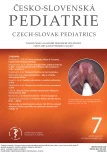Laryngomalacia – when to operate?
Authors:
B. Blatová 1; Karol Zeleník 1,2; J. Pavlíček 3,4; Pavel Komínek 1,2
Authors‘ workplace:
Klinika otorinolaryngologie a chirurgie hlavy a krku, Fakultní nemocnice Ostrava
1; Katedra kraniofaciálních oborů, Lékařská fakulta Ostravské univerzity v Ostravě
2; Klinika dětského lékařství, Fakultní nemocnice Ostrava
3; Katedra dětského lékařství a neonatologie, Lékařská fakulta Ostravské univerzity v Ostravě
4
Published in:
Čes-slov Pediat 2021; 76 (7): 378-381.
Category:
Case Report
Overview
Laryngomalacia is the most frequent cause of inspiratory stridor in infants. It is a congenital anomaly that causes the collapse of soft supraglottic structures and indrawn into the larynx and inspiratory stridor is showed. The course of the disease is not serious in most cases. It doesn´t need treatment and symptoms spontaneously disappear. The severe course has occurred in 10% of all cases. Failure to thrive, swallowing problems, suffocation, and aspiration are presented. It is important to considersurgery – plastic of vestibulum laryngitis (supraglottoplasty) in these cases.
Keywords:
surgery – diagnosis – laryngomalacia – infant – treatment – stridor – supraglottoplasty – epiglottopexy
Sources
1. Olney DR, Grainwald JH, Smith JH, et al. Laryngomalacia and its treatment. Laryngoscope 1999; 109 (11): 1770–1775.
2. Monnier P. Pediatric Airway Surgery. Berlin, Heidelberg: Springer Berlin Heidelberg, 2011: 99–106.
3. Jakubíková J. Vrozené anomálie hlavy a krku. Praha: Grada, 2012: 79–83.
4. Mistrík M. Vrodené a geneticky podmienené ochorenia dýchacieho traktu z pohľadu genetika. Čes-slov Pediat 2020; 75 (1): 16–19.
5. Dobbie AM, White DR. Laryngomalacia. Pediatr Clin North Am 2013; 60 (4): 893–902.
6. Jovankovičová A, Szaboová I. Laryngomalácia u detí. https://health.gov.sk/Zdroje?/Sources/dokumenty/SDTP/standardy/ 17-03-2021/Laryngomalacia-u-deti.pdf.
7. Jakubíková J, Pavlovčinová G, Belicová J. Chirurgická liečba laryngomalácie: ako uchrániť novorodenca a dojča před tracheostómiou. Pediatra pre prax 2009; 10 (1): 36–37.
8. van der Heijden M, Dikkers FG, Halmos GB. The groningen laryngomalacia classification system-based on systematic review and dynamic airway changes. Pediatr Pulmonol 2015; 50 (12): 1368–1373.
9. Ayari S, Aubertin G, Girschig H, et al. Management of laryngomalacia. Eur Ann Otorhinolaryngol Head Neck Dis 2013; 130: 15–21.
10. Alberta D, Bailey M, Lindley K, Pierroc A. The effect of aryepiglottoplasty for laryngomalacia on gastro-oesophageal reflux. Int J Pediatr Otorhinolaryngol 2003; 67 (1): 11–14.
11. Bodláková M, Jurovčík M, Katra R, et al. Stridor kongenitálního původu. Otorinolaryng a Foniat (Prague) 2019; 68 (1): 30–35.
12. Samuel D. The upper airway: Congenital malformations. Paediatr Respir Rev 2006; 7 (1): 260–263.
13. Čábalová L, Komínek P, Zeleník K. Obstrukce dýchacích cest u dětí z pohledu otorinolaryngologa. Pediatr praxi 2014; 15 (2): 70–73.
14. Doušová T, Pohůnek P. Stridor. Čes-slov Pediat 2015; 70 (6): 371–373.
15. Venkatesan NN, Pine HS, Underbrink M. Laryngopharyngeal reflux disease in children. Pediatr Clin North Am 2013; 60 (4): 865–878.
16. Richter G, Thompson D. The surgical management of laryngomalacia. Otolaryngol Clin N Am 2008; 41: 837–864.
Labels
Neonatology Paediatrics General practitioner for children and adolescentsArticle was published in
Czech-Slovak Pediatrics

2021 Issue 7
Most read in this issue
- Laryngomalacia – when to operate?
- Newborn resuscitation and support of transition of infants at birth 2021
- Non-surgical treatment of pectus excavatum in children
- A new strategy for the treatment of X-linked hypophosphatemic rickets
